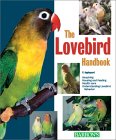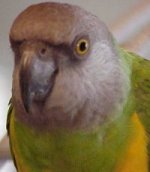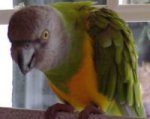Why Did My Bird Bite Me?
The typical scenario is this. You’ve owned your bird for a year or so. It has been your darling, adoring pet, never balking at cuddling and kisses. Then one day with no warning, your bird strikes out and bites. Most owners express shock and disappointment when their beloved pet shows such unexpected aggressive behavior. But how unexpected should this behavior really be?
Most parrots cannot be considered domesticated pets. With the exception of budgerigars and cockatiels, most species are only a few generations removed from their wild ancestors. Some birds sold as pets today may have had wild-caught parents. What does this mean? It means that instincts rule. If bird owners keep this in mind when training their pets, they will have a healthier relationship with their bird and there will be far fewer painful nips.
Keep in mind that in the wild birds can fly high in the trees to avoid danger. A bird with clipped wings obviously cannot do this. Some will fly in a panic to the floor, thrashing about. This can be a very frightening and unsettling experience for both the bird and the owner. It is best to get down low to where the bird is and not “swoop” down on it the way a predator might in the wild. Talk in a calm voice and ease the bird’s panic. The other protection your bird has is to bite. In almost all cases, you will get warning signals. The trick is to learn how to recognize them before the beak comes down on your finger (or worse, a lip or ear).
I have discovered a whole repertoire of behaviors with my senegal parrot. I have learned to pay close attention to them. When Maxwell reached sexual maturity at around four years of age, his personality changed. I had to rebuild our relationship on different terms. I had to learn to recognize when he was overstimulated (it is often called “overload” in amazons) and likely to snap. Mainly I was the cause of the overstimulation. We often played a game called “The Tail Thief”, which he loved as a young bird, but at age four he would become very aggressive if I played the game. I’ve relegated the game to memory lane now. Many owners of pet birds become disappointed when they cannot play with their bird in the same manner as they mature. It is very important to accept your bird as an individual and not try to force behaviors just because you enjoy them. I have found that once owners try to understand their bird’s moods rather than trying to change their moods, the relationship blossoms again.
There are some pretty universal signs when a bird is saying, “Back off”. Your relationship will be the most healthy when it involves reciprocal “respect”. If my senegal puffs himself up and his eyes start to flash, I don’t reach in saying, “Oh it’s sooo cute!” I calm him down first using a soothing voice. Max is very well trained for stepping up on command, but there are times when I can tell by his body posture–feathers out a bit (almost arched), individual feathers a bit on end, some extra loud clicking of the beak, eyes flashing–that he might just be too stimulated and could bite. I really don’t believe these bites mean he’s angry at me, just that he very excited and can’t quite control himself . Sometimes these signs are subtle, sometimes they’re done in an outright “flash” dance. Above is a series of photos, from a content bird to a visibly agitated bird. While I can usually calm Max down from this “stance,” I don’t just reach in fast with my hand if he begins to show these signals.
The foundation you build with a young bird will make all the difference in how you can handle him when he reaches maturity. Books on parrot behavior may help you, but the best way to learn the signs is to watch your bird and make a note of specific reactions. For example, “When I move quickly like that he spins around. This means I’ve startled him and an instinctive response has kicked in. I need to talk to him first.” One special thing to look for is when your bird seems to be in a trance-like state. This is a natural protective behavior. In the wild parrots “take turns” standing watch for the flock for any danger. They are in a hyperalert state at that time, blocking out all extraneous (i.e., nondangerous) stimuli. A sudden movement or threatening approach during that “trance” can make them lunge instinctively.
It is important to note that birds that have shown aggressive behavior should NOT be allowed to sit on your shoulder. A startled bird can bite your face and do serious injury. Certain species, such as amazon parrots, should be trained to sit on your hand or wrist, never on your shoulder. While re-training a bird used to sitting on your shoulder can be challenging, it is not impossible.
All of your bird’s seemingly unpredictable behaviors can be largely predictable if you accept that they are part of a whole repertoire of natural instincts. Unfortunately, most people give up after the first few bites and don’t understand why their sweet baby has become a piranha. By establishing a few basic rules early on in your relationship with your bird, you can work through these behavioral issues, and your pet does not have to end up on the adoption merry-go-round.














